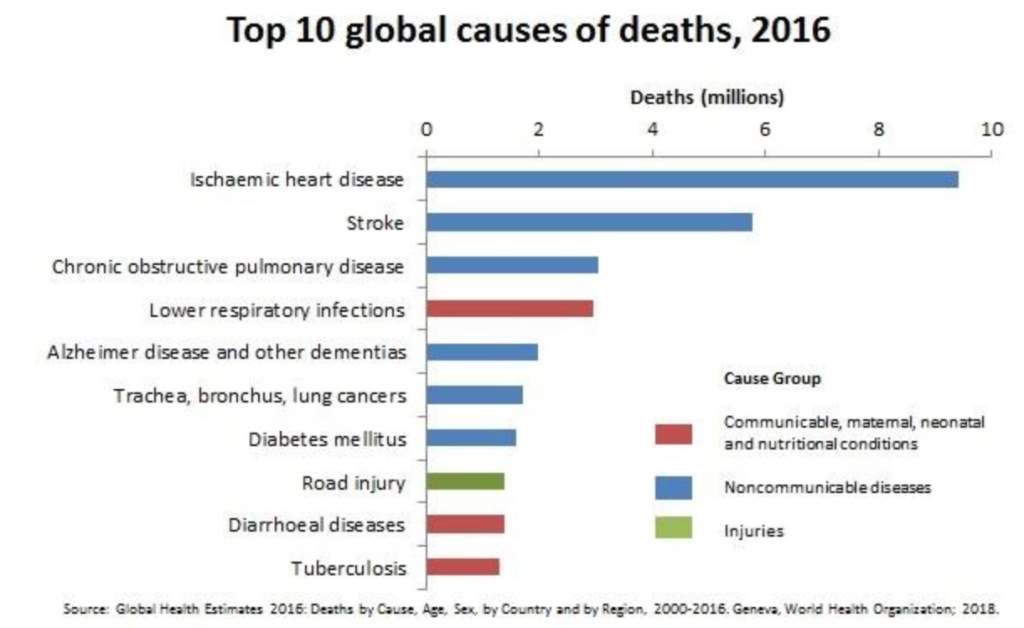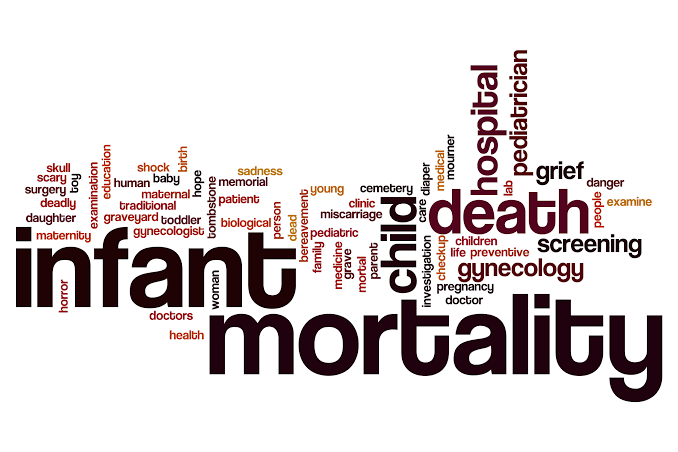Death, which is the permanent cessation of all biological functions that sustain a living organism, is commonly a result of ageing, predation, malnutrition, disease, suicide, homicide, starvation, dehydration and accidents or major trauma resulting in terminal injury. Generally, records of death (including the numbers of persons who died as well as the causes of the deaths) provide insights on the effectiveness of a country’s health system.
With 56% of mortality in Africa is caused by communicable, maternal, neonatal, and nutritional conditions, Africa is the only region with the record of such a high percentage of death through these causes globally.
According to WHO, of all the death recorded in 2016 across the world, more than half were due to the top 10 causes of death which are categorized into the following three groups:
The figure below shows the number of deaths recorded globally as caused by the WHO’s top causes of death. 
Ischaemic heart disease, stroke and pulmonary disease are the highest killers. Combined, they cause 49.4% of deaths in 2016 globally. Road injuries were responsible for just 4.5% of the total deaths. However, about three-quarter of them (74%) of these road injuries resulted in the death of men and boys. It is interesting to know that HIV/AIDS is no longer among the top 10 causes of death as its number of claimed victims has dropped drastically.
In developing countries (Nigeria inclusive), the number of deaths from the top 10 causes has a reverse order. According to WHO, Africa is the only region where communicable, maternal, neonatal and nutritional conditions still dominate, causing 56% of deaths in 2016. The statistics are shown in the chart below. More than half of all deaths in low-income countries in 2016 were caused by the so-called “Group I” conditions, which include communicable diseases, maternal causes, and conditions arising during pregnancy and childbirth, and nutritional deficiencies.
More than half of all deaths in low-income countries in 2016 were caused by the so-called “Group I” conditions, which include communicable diseases, maternal causes, and conditions arising during pregnancy and childbirth, and nutritional deficiencies.
Non-Communicable Diseases (NCDs) claims for 37% of the deaths in developing countries. Developing countries have the highest mortality rate due to road traffic injuries with 29.4 deaths per 100,000 of the population.
Statistics on the mortality rate and the causes of mortality help governments to reposition their health institutions for enhanced service delivery. They also help the government in the course of its public health policy and practices. For instance, a country with a fast-growing record of mortality from heart diseases and diabetes may opt to promote lifestyles and habits that help to prevent these illnesses. Similarly, a country with high infant mortality from pneumonia can commit more financial resources to effective treatment of this condition.
To a country like Nigeria where communicable diseases, maternal, neonatal, and nutritional conditions still result in a handful of deaths, efforts should be placed on directing policies and interventions towards these conditions. Also, public enlightenment campaigns should be staged to inform citizens on the various ways to avoid these conditions as well as the existing health interventions that have been put in place to address these conditions.




